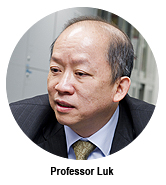CityU antenna research team receives State Technological Invention Award
Mirror Fung
The team is led by Professor Luk Kwai-man, Director of the State Key Lab and Chair Professor in the Department of Electronic Engineering (EE). The other three scholars in the team are Professor Chan Chi-hou, Chair Professor in EE, Professor Xue Quan, Associate Vice-President (Innovation Advancement and China Office), Deputy Director of CityU Shenzhen Research Institute and Professor in EE, and Dr Steve Wong Hang, Senior Engineer in the State Key Lab.
Their winning project is titled “Invention, theoretical and experimental investigation and applications of some novel antennas”.
The team has invented five types of novel antennas: the wideband patch antenna, magneto-electric dipole antenna, compact circularly-polarised patch antenna, differentially-fed wideband patch antenna, and folded-plated-fed small wideband patch antenna.
“Antennas used in wireless communication have to be small and thin, but maintain high efficiency, such as high gain and wide bandwidth. Researchers have to come up with innovative ideas,” Professor Luk said.One of the disadvantages of the traditional patch antenna is its narrow bandwidth. The CityU team made a breakthrough by changing the shape of the antenna, resulting in an increased bandwidth from less than 2% to more than 30%.
This new generation of wideband patch antenna is called the L-probe patch antenna. “It can be deployed by many new generation wideband patch antennas, such as mobile communication base station antennas, wireless network base station antennas, and Radio Frequency Identification (RFID) reader antennas,” Professor Chan said.The tailed-slot patch antenna is used by the Beidou system, a global positioning system developed by China for helping emergency teams identify their positions and enable smoother communication in the rescue work following the 2008 Sichuan earthquake.
“We are deeply honoured to receive the STIA,” Professor Xue said. “It is one of China’s most prestigious awards in the national science and technology sector, and there are many outstanding scientific researchers in China nowadays.”In addition to navigation and communication areas, advanced antennas can also be used in medical treatment, said Dr Wong, now Acting Assistant Professor at Stanford University. “CityU is working with Stanford on the biomedical applications of wireless signal transmission and reception technology,” he said.
The State Key Lab is widely recognised for its research capacity. It won a RMB 5 million research grant from the China National Astronomical Observatory for developing a new terminal antenna for its global positioning system, and $14 million from the Hong Kong Innovation and Technology Commission and Comba Telecom Systems (Guangzhou) Limited for a new wideband smart antenna system for mobile communication.



